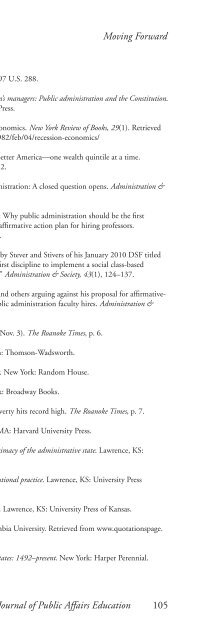WINTER 2012 - National Association of Schools of Public Affairs and ...
WINTER 2012 - National Association of Schools of Public Affairs and ...
WINTER 2012 - National Association of Schools of Public Affairs and ...
Create successful ePaper yourself
Turn your PDF publications into a flip-book with our unique Google optimized e-Paper software.
Creating Quality Online Course Design<br />
difficult exercise in constructing course activities. The challenge is in accurately<br />
identifying the connection between specific materials <strong>and</strong> instruction <strong>and</strong> the<br />
student actions that manifest learning <strong>of</strong> stated objectives.<br />
Although making the connection between instructive materials <strong>and</strong> student<br />
actions is inherently an informal exercise in thinking about <strong>and</strong> creating<br />
coursework, efforts to quantify those associations have led to several alterations<br />
in required course activities. For instance, the traditional classroom setting might<br />
call for a “participate grade” that attempts to capture the informal discussion <strong>and</strong><br />
observed group dynamics within class exercises. The online environment <strong>of</strong>fers<br />
blogs <strong>and</strong> wikis, which allow for this type <strong>of</strong> informal discussion to take place.<br />
Case study analysis, simulations, <strong>and</strong> student presentations augment the st<strong>and</strong>ard<br />
discussion board as strategies to achieve learning objectives. Many instructors<br />
have included assessments that build on the interactive component <strong>of</strong> Bb, using<br />
Wimba classrooms <strong>and</strong> Voice Boards (audio-based threaded discussions) to assess<br />
critical thinking skills, presentation skills, <strong>and</strong> public speaking performance.<br />
Each <strong>of</strong> these tools allows for greater planning <strong>and</strong> definitive demonstration <strong>of</strong><br />
the relationship between course objectives <strong>and</strong> manifested learning.<br />
Learner Interaction <strong>and</strong> Activities<br />
Research suggests that interaction in the online environment should include<br />
student-to-student, student-to-faculty, <strong>and</strong> student-to-content interplay (Moore,<br />
1989). In the MPA Program, activities have been formulated to promote these<br />
exchanges. The syllabus template <strong>and</strong> Bb course shell contain a required plan<br />
for interacting <strong>and</strong> communicating with students <strong>and</strong> articulating how students<br />
are expected to interact with the instructor. For instance, at the beginning <strong>of</strong><br />
the course, discussion boards are introduced with two forums: an “Ask the<br />
Instructor” forum where students can, throughout the term, post questions<br />
pertaining to the course <strong>and</strong> suitable for general consumption, <strong>and</strong> a “Student<br />
Introduction” area in which all participants provide information that moves<br />
them beyond simply an identity defined by an e-mail address. It was discovered<br />
that students were more willing to participate <strong>and</strong> open in their introductions<br />
when instructors posted a photo <strong>and</strong> their own personal biography first. The<br />
degree <strong>of</strong> formality, depth <strong>of</strong> information disclosed, <strong>and</strong> style <strong>of</strong> the pr<strong>of</strong>ile<br />
created by the instructor projects important information to the students as to<br />
how interactions are expected to be held. Similar to what happens in a brick<strong>and</strong>-mortar<br />
classroom, the online “community” calls for individual effort to<br />
establish an identity <strong>and</strong> be an active participant; however, online instructors<br />
like to say, “You can’t hide in the back <strong>of</strong> the room when online.” Concerted<br />
effort to ascertain how much personal information should be provided through a<br />
keyboard <strong>and</strong> engagement with the instructor <strong>and</strong> class members throughout the<br />
day <strong>and</strong> week are challenges unique to the creation <strong>and</strong> cultivation <strong>of</strong> a “class”<br />
without time or space limitations.<br />
Journal <strong>of</strong> <strong>Public</strong> <strong>Affairs</strong> Education 215

















